1974 Italian Grand Prix race report
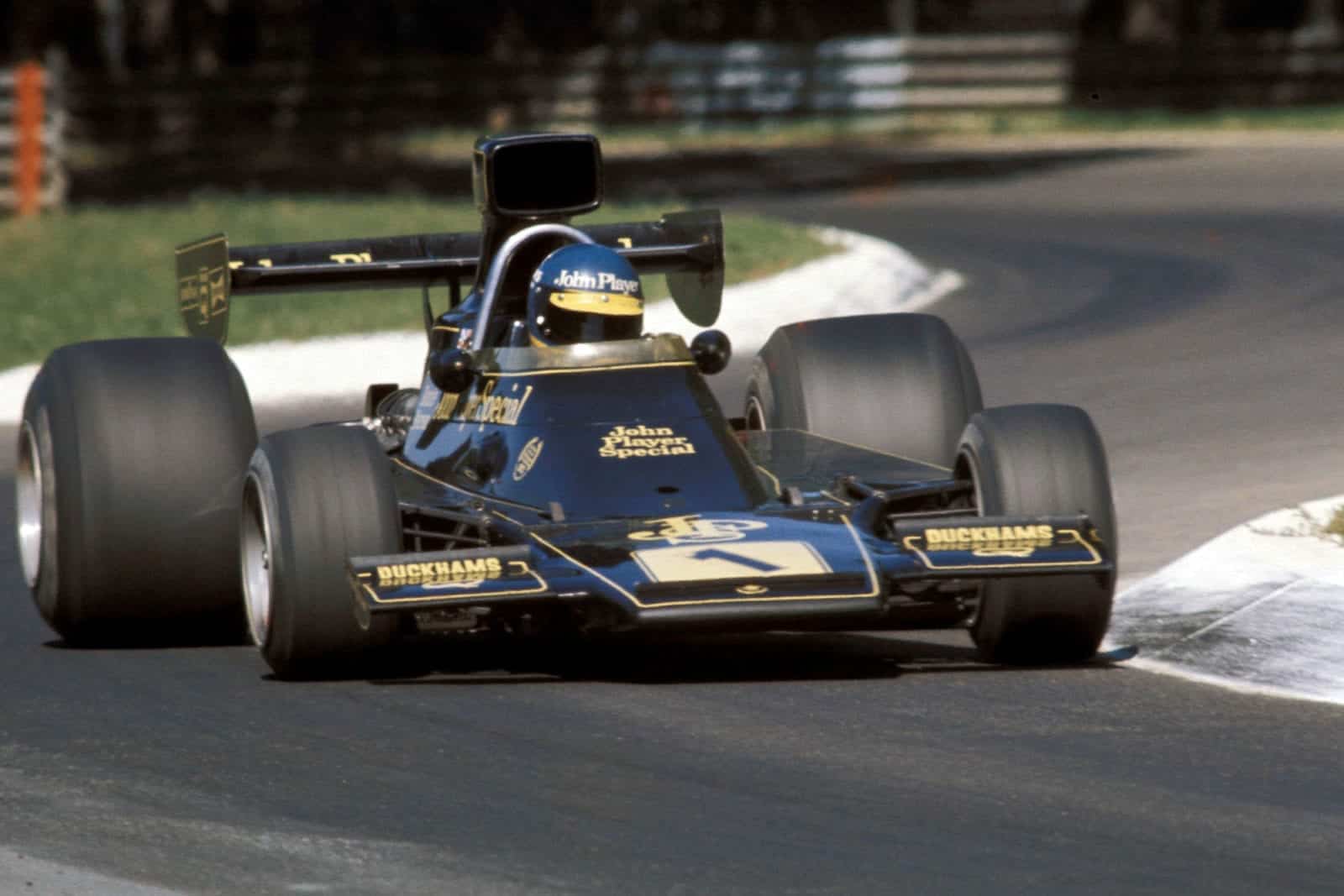
Ronnie Peterson was victorious for Lotus at historic Monza
Motorsport Images
Peterson keeps the faith again
Monza, September 8th
The cast for the last Grand Prix in Europe for 1974 was fairly stable, the only new car on the scene being a fourth BRM P201, which Pescarolo was driving, the Bourne team having got themselves sorted out for a brief moment; Beltoise had P201/03 and Migault P201/02. Team Lotus had made a decisive move in taking their two Lotus 76 models and one Lotus 72 to Monza, the idea being to race the new cars and have the old one purely as a stand-by; it was Peterson’s usual mount, 72/R8, the new cars being the troublesome JPS/9 and JPS/10. Elf Team Tyrrell were in their usual good order, with their three 007 cars for Scheckter and Depailler, and the McLaren team were with their usual three cars for Fittipaldi and Hulme, and the Yardley sponsored M23/4 for David Hobbs, still standing-in for Mike Hailwood, who was reported to be recovering well and with enthusiasm. The Texaco-Marlboro sponsored McLarens were not using the transparent skirts round the base of the monocoque that they tried in Austria, not because they were not beneficial, but because there was no way they could be prevented from rubbing themselves away and if they did not touch the ground they were ineffective. Any method of keeping them in contact, rising and falling as the suspension worked, would have contravened the “moveable aerodynamic device” rule. The Brabham team were in good spirits after their win in Austria, confident that their cars would be equally as good on the fast Monza circuit. The two South American drivers were unconsciously urging each other on to greater efforts in friendly rivalry, Reutemann knowing he could go faster than Pace, and vice-versa. John Watson, in the brown Hexagon Brabham BT44/4, with support from the works team, was equally happy and confident, being delighted with his new car.
Surprisingly, Ferrari kept to their usual two-car team for their home Grand Prix, instead of co-opting anyone into a spare car, as they have done in the past. Regazzoni and Lauda had the same two cars they used in Austria, which were 014 and 015, respectively. The Shadow team were unchanged, although their spare car had been straightened out, but Pryce was still feeling a bit bewildered and very lucky at having escaped injury in a Formula Two crash at Enna a short time before. Team Surtees had called the Formula Two driver Jose Dolhem into his troubled team once more, with Derek Bell in the number one car, and Frank Williams had Merzario and Laffite in his cars once more, while Graham Hill had Stommelen with him in the Lolas, as he had done in Austria. The private efforts of Amon, Kinnunen, Hunt and Schenken were unchanged and the Ensign had reverted to its original green and yellow colour scheme, no longer being supported by Theodore Racing, and as in Austria Mike Wilds was driving it. Ian Ashley’s backers had dropped the Token car and bought the Brabham BT42/2 that Watson has been racing all season, but it could not be made ready in time for the Italian race. The Swiss/ Italian team run by Finotto/Bretscher had only one of their cars running, although they had entered two, and Carlo Facetti was the driver. The March team was unchanged, with Stuck and Brambilla in the 741 cars, the stocky Italian keen to do well on his home ground, Monza being his local circuit.
The Formula One Constructors Association planned the distribution of the pits, there being more cars and teams than Monza could really deal with, so a sad little group were farmed out on to the grass verge at the beginning of the pit road, while the rest had enough room in the concrete covered pits. The outcasts were Facetti with the bright blue Brabham, Ron Tauranac with his Trojan, Chris Amon with his own car, Wilds with the Ensign, Kinnunen with his Surtees and Graham Hill with his Embassy-Lola team, the last-named being something of a surprise decision by the selection committee. Fortunately the weather was typically Italian, so being “put out to grass” was not as disastrous as it might have been. Most of the competitors have retained the same racing number all season, but for this race there was a bit of shuffling round among the tail-enders, with Amon, Kinnunen, Wilds, Schenken and Migault having different numbers in the entry list, though the third BRM reverted to its normal 37.
Qualifying
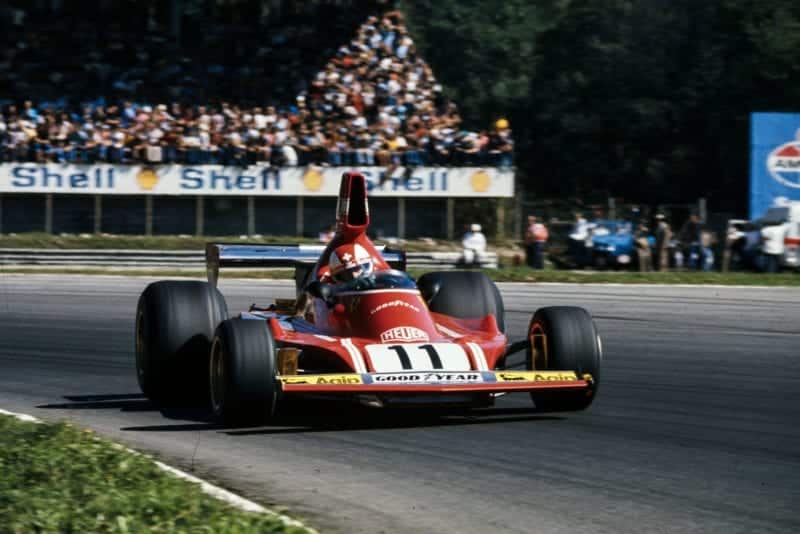
Clay Regazzoni put his Ferrari 5th on the grid front of the manufacturer’s home crowd
Motorsport Images
Practice was held on Friday and Saturday, from about midday to 3.30 p.m. each day, with a half-hour break for towing in any cars that had broken down, or repair any ravages caused by over enthusiasm. The sun shone down splendidly as the two Ferraris began to set the pace, but it was soon obvious that Reutemann and Pace in the Brabham were not going to let them get away, these four being the pacemakers, joined after a while by Fittipaldi and Depailler. The Frenchman’s Tyrrell had extra water radiators on each side of the car, mounted just in front of the rear wheels. Scheckter was feeling a bit off colour, and not being encouraged by his Cosworth engine suffering from fluctuating fuel pressure, so he was not going as fast as expected. He did a few slow laps in the spare car, but all told was not in his usual fast form. Team Lotus seemed to be making little progress, and for the second half of Friday’s practice Peterson went out in his Lotus 72, abandoning the Lotus 76.
Since last year the permanent chicane on the back leg of the circuit has been made even more permanent and generally tidied up so that the exit is much quicker, while the chicane on the pits straight remained ostensibly unaltered, with an escape road for anyone overshooting. Last year’s fastest practice lap was 1 min. 34.80 sec., set by Peterson in the Lotus 72, and this was well beaten during the first half of Friday’s practice. Reutemann was fastest with 1 min. 33.64 sec. and a lap in the 1 min. 33 sec. bracket was clearly going to be an “ace” time, Lauda joining the Argentinian in this select group. During the second half Stuck’s March had its nose-cone mounting break away and this sent him off the road in a spectacular way after the Curva Grande, the car being badly bent but the young German stepping out unscathed. The furious pace being set by the Brabhams and Ferraris was leaving everyone else behind and rather depressed, particularly the Lotus team who were virtual also-rans in the battle for the front row of the grid. Peterson gave up the struggle with the Lotus 76 and reverted to his old-faithful Lotus 72/R8, but Ickx had no alternative but to stick with the new car. Some drivers were as many as seven seconds slower than Reutemann, which must have been very depressing for there cannot be that much difference in Cosworth engines. Building a Formula One car is one thing, getting all the adjustments in unison is another thing all together, and watching the Brabhams through the Curva Parabolica it was very clear that they were nicely balanced and the drivers could really get on with the business of cornering fast, without having to worry about the car changing its attitude angle once it was aimed right. The Williams cars were also nice and smooth in their handling, but some of the others were horrible to watch, the drivers having to take big handfuls of opposite lock at the wrong moment to counteract a slide. At Monza there are raised concrete benches all along the public enclosure and you can virtually look down into the cockpits and see the driver working, in spite of what “vintage minded” people may say. Reutemann ended the day with the fastest lap, in 1 min. 33.27 sec., but Lauda and Regazzoni were right behind him, no-one else being in their league.
That evening an almost tropical rainstorm hit the northern part of Italy and it cleared the air and got rid of the heaviness in the atmosphere, so that Saturday was warm and clear and hotter than ever when practice started again at midday. Reutemann did a few laps in the spare works Brabham, but soon returned to his usual car, whereas Peterson continued to work away in his spare car, virtually abandoning the Lotus 76. The March mechanics had straightened out Stuck’s car and he resumed practice only to come to another stop, more gentle this time, when a drive-shaft broke. Before the half-way pause there was an involuntary break when Hobbs clipped the exit of the chicane on the pits straight and bounced across the road and into the barriers, bending the front of the car, so everyone stopped while the breakdown lorry collected the bent car. Carlos Pace had now joined the 1 min. 33 sec. group, as had Fittipaldi, while both Ferraris were well into it, with Lauda down to 1 min. 33.16 sec., which took pole position on the grid from Reutemann. With 31 drivers competing for 25 positions on the starting grid there were a few traumas going on amongst the rabbits at the end of the field, though some were so hopeless (relative to the top group that is) that they more or less gave up all hope of getting into the race. Peterson had one final fling with the Lotus 76 in the last part of practice, but was not as fast as he had been in the Lotus 72, and that was not fast enough to be impressive anyway. The outcome was becoming very clear, it was two Brabhams against two Ferraris, with Fittipaldi in his McLaren hovering just behind them, but the Maranello hopes received a surprise blow when John Watson pulled out all the stops and did 1 min. 33.63 sec. in the Hexagon-of-Highgate semi-works Brabham, thus ousting Regazzoni from the second row of the grid. Watson’s progress during practice had been a model of a driver getting on with the job as the car was “trimmed” to suit the conditions, from knowledge and information imparted to the small private team by the Brabham designer, Gordon Murray. Watson’s best times in the four sessions were 1 min. 35.31 sec. , 1 min. 34.99 sec., 1 min. 34.08 sec. and 1 min. 33.63 sec. And then the brown Brabham spun off the course at the Lesmo bends and destroyed itself, the driver stepping out unhurt! It was not a case of over-enthusiasm, a rear wheel had broken and sent the car helplessly out of control.
So practice finished with a Ferrari on pole position with three Brabhams very close behind it and blocking the second Ferrari, which had a McLaren breathing hard on it. The Hexagon Brabham BT44/4 was too badly bent to be repaired in the paddock, but Bernie Ecclestone did not hesitate about offering the loan of the spare works car to Watson. There were a few minor problems to sort out, such as making it fit the bearded Irishman, and the fact that the works cars run on Goodyear tyres while the Hexagon car ran on Firestone tyres, but all went well and Watson was ready to give the car a try-out in the untimed practice on Sunday morning, which is the reason for the extra half-hour usually provided on race morning. Lauda was also grateful for it as his car had a new engine fitted on the Saturday night. It does not need much of a clairvoyant to know who the unlucky ones are going to be when there are more drivers than places on the starting grid and once again there were no surprises; Dolhem (Surtees), Facetti (Brabham), Bell (Surtees), Wilds (Ensign), Amon (Amon) and Kinnunen (Surtees) being left behind.
Race
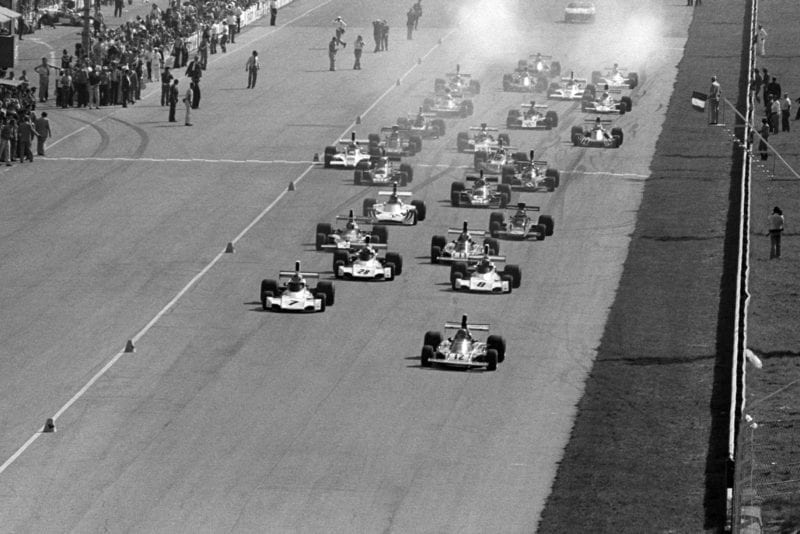
The race gets underway
Motorsport Images
It was still blazing hot on Sunday and the Monza Autodrome was packed to capacity, the majority of the spectators being Ferrari supporters needless to say, and with Lauda on pole position and Regazzoni in the lead of the World Championship for Drivers, all was set for an Italian “joy day”. Before the start there was a bit of a “rhubarb”, for Goodyear had decided that the latest type could not be used and all the contracted runners had to back-pedal one step and revert to the not-quite-so-good tyres, and the odd one or two on Firestone tyres actually thought they might have a chance of winning a Grand Prix, but it all turned out to be relatively unimportant. One by one the cars set off on a warm-up lap, doing a flying lap as well before forming up on the “dummy-grid” in two-by-two formation. Lauda (Ferrari) and Reutemann (Brabham) were on the front row, followed by Pace (Brabham) and Watson (Brabham) on row two, the Irishman in the white spare works Brabham in place of his usual brown one. Then came Regazzoni (Ferrari) and Fittipaldi (McLaren), Peterson (Lotus 72) and Hunt (Hesketh), Jarier (Shadow) and Depailler (Tyrrell) and Beltoise (BRM) and Scheckter (Tyrrell), followed by the rest down to Pescarolo all alone in the back row, while Dolhem as first reserve waited at the ready in the pits in case anyone failed to line up at the last moment.
All 25 runners were in good order, or seemed to be, and the field moved up to the start line, ready for the 52 lap race. Lauda made the most blatant jump-start„ but overdid the wheelspin and did not rocket away from Reutemann and the others as expected, though he did lead into the Curva Grande, the chicane not being used on the opening lap. In the middle of the field, and pulling off to the side was the BRM of Beltoise, its engine having died on him, the remaining 24 cars disappearing in a dust cloud. Down the back straight Lauda pulled out all the stops and was well ahead as they braked for the Curva Parabolica, and his lead as he came into view of the pits and grandstands was such that the Ferrari followers cheered hysterically while the rest gasped in disbelief. The order of the main pack as they went by was Lauda, Reutemann, Pace, Watson, Regazzoni, Peterson, Fittipaldi, Hunt, Brambilla, Depailler, Scheckter, Ickx and Jarier. As the tail-enders went by Migault could be seen heading for the pits, his BRM suffering from a broken shaft in the gearbox. Next time round Regazzoni and Peterson had got by Watson, the Irishman finding that his car had far too much braking on the rear wheels, there having been no time during his brief acquaintanceship with the new car to sort out the balance. Half way round the third lap the Hesketh blew up its Cosworth engine and Hunt started a hot walk back to the pits, and next time round it was Pescarolo who started to walk, his BRM breaking its engine pretty disastrously. The dust from the start had hardly settled and all three BRMs had retired. Regazzoni had overtaken Pace on this lap and on lap 5 he overtook Reutemann to move into second place, and as he came into view from the Curva Parabolica the Swiss contingent in the main grandstand were delirious. This was indeed a joy-day for Italy and Ticino, and Ferrari flags and Swiss flags were waving all round the circuit as the two red, cars powered away into a commanding 1-2 domination, with Lauda nearly 7 seconds ahead of his team-mate. Watson was losing ground due to being unable to brake to the limit, and Pace began to drop back when a rear tyre began to lose bits of its outer skin. Pryce made a stop to change the left-front tyre on his Shadow on lap 8 and on the next lap Watson went straight on at the pits chicane due to being unable to stop, and spent a long time sorting himself out, so that he dropped to the back of the field. By ten laps a pattern was appearing, with Lauda way out in front on his own, Regazzoni in second place, with Reutemann keeping in touch, and in fourth place the black and gold Lotus of Peterson, in a far better position than practice would have suggested. Fittipaldi was fifth, and a courageous Brambilla was sixth. Then came a gap, and the struggling Pace led the midfield runners who comprised Scheckter, Depailler, Ickx, Jarier, Stommelen (doing extremely well with the over-weight Lola) and Schenken who was making good progress with the Trojan. After another gap came Stuck leading Merzario, Laffite and Hulme, the New Zealander having committed an indiscretion in the opening laps which had dropped him to his lowly position of seventeenth. Bringing up the rear were Graham Hill and David Hobbs, having a nice little race all on their own. Watson and Pryce were far beyond trying to make up for lost time.
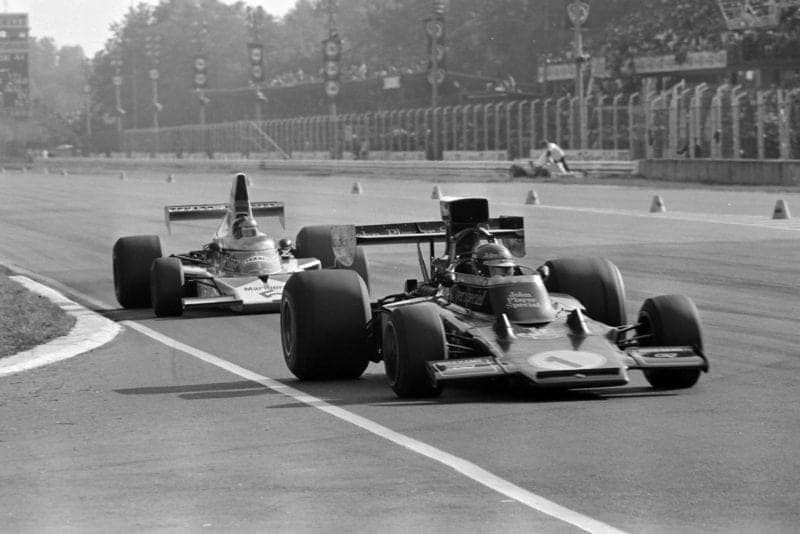
Fittipaldi tracks Peterson
Motorsport Images
At the end of 12 laps Reutemann headed for the pits, and Peterson moved up into third place, behind the two Ferraris. The Brabham team leader had felt an awful rumbling and vibrating coming from the back of the car, and it did not take long for his mechanics to diagnose that the Hewland gearbox was breaking up, and the car was wheeled away. On the same lap Stuck came in to say that his March was feeling peculiar, and as it was about to break in two, where the engine joins the monocoque, this was not surprising. On lap 15 the Trojan retired, with gearbox failure, and at that point the Italian commentator was just praising Brambilla, who was not only the leading Italian in the race but also in a very worthy fifth position, when the stocky little man from Monza clipped the pits chicane on the exit and bounced off into the barriers, just as Hobbs had done in practice, the March coming to a halt rather bent. As Brambilla walked back to the pits he got a very big ovation from the crowd, for no-one minds a driver making a mistake when he is having a real go. The pits were still very busy for Ickx had crept quietly in with a broken ball-joint in the throttle linkage and Stommelen had been forced to stop as his Lola seemed to be steering itself. While Ickx’s car was repaired and he rejoined the race for a time until another part of the linkage broke, for Stommelen it was the finish, for the rear suspension was coming adrift. With all this trouble in the mid-field the tail-enders who were having trouble-free runs were moving up impressively on the lap charts, and Merzario was up to eighth place by lap 20, and Jarier retired when his engine seized up. Laffite was the next to go as his engine failed on lap 22, and on the next lap Depailler misjudged the pits chicane, bounced off the kerb and limped round to the pits to have a new rear wheel fitted to the right-hand side.
Ever since he had got into second position, on lap 5, Regazzoni had been holding the gap between himself and Lauda pretty constant, even closing it up slightly at times, and at 25 laps it was 6.7 seconds, but he could now see signs of trouble ahead, for on the over-run the leading Ferrari was beginning to puff out blue smoke from its exhausts, a sign of something going wrong inside the engine. By lap 28 it was really smoking badly, and slowing, and on lap 30 Regazzoni took the lead as Lauda’s car slowed dramatically. At the end of lap 32 it was all over for the young Austrian, and once again the Ferrari engine that everyone thought was so strong had let him down. He went into the pits not to return, the engine having suffered internal damage, and Regazzoni was left in a strong position, more than 12 seconds ahead of Peterson, who still had Fittipaldi nibbling away at his exhaust pipes. A bare ten laps more and Regazzoni’s car began to smoke in the same way that Lauda’s had done and the Ferrari supporters and the Swiss spectators nearly wept as the smoking got worse. It was clear that Peterson and Fittipaldi were soon going to be racing for first place, and on lap 39 the Brazilian outbraked the Swede into the pits chicane and got in front, albeit slightly out of control, so that he took quite a time to get sorted out after the chicane, and Peterson was back in front in no time at all.
At 40 laps Regazzoni headed for the pits, the Ferrari engine about to do itself a serious mischief, and after everyone had gone by he rejoined the race, urged on by the vociferous crowds, but he only got as far as Lesmo when the flat-12 cried “Enough” and he parked the car on the grass verge. The Italian and Swiss supporters rolled up their flags and set off for home, bitterly disappointed after such a glorious beginning. This left Peterson and Fittipaldi battling for the lead, although it was not much of a battle, for the Brazilian had made his pass to take the lead, and it had not come off, and there did not seem much more he could do except keep pressing the Lotus in the hope that it would break down. In truth it was making an odd noise, but it was only a loose tail-pipe, and providing Peterson could keep going for the remaining twelve laps the Italian Grand Prix was his. Thus it was, with the faithful old Lotus 72 chalking up yet another victory and Fittipaldi following home in second place, these two having been up at the front for the whole race. Scheckter was third, having moved steadily up from tenth place as those in front struck trouble, and by the same process Hulme moved up from seventeenth to sixth place by the end.
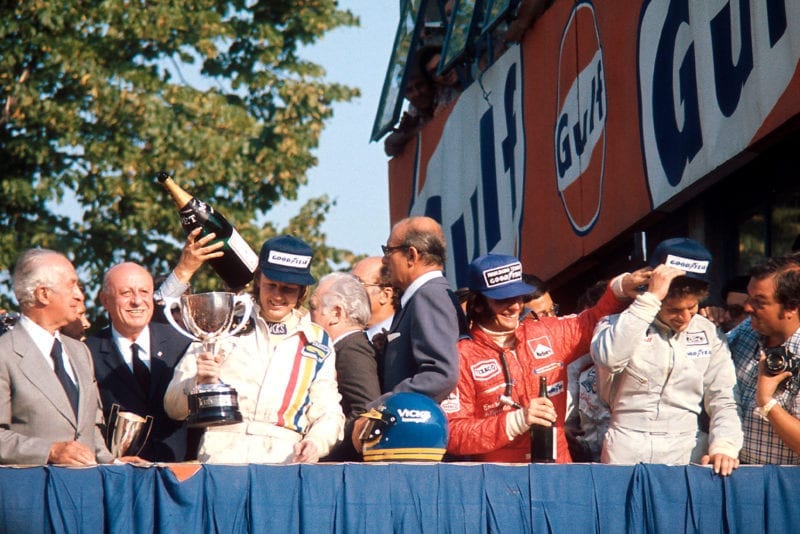
Peterson shows his joy at winning
Motorsport Images
Merzario had moved up in a similar steady manner to finish fourth, and in fifth place was a fighting Carlos Pace. The Brazilian Brabham driver had struggled on with his tyre disintegrating until he was forced to stop and have it changed, when it was found that the out-of-balance vibration had broken one of the mountings of the rear anti-roll bar. It could not be repaired so he rejoined the race knowing full well why his car was not handling as well as it should. This had been on lap 22, when he was lying eighth, and the stop dropped him to the back of the field into 12th place. Once he had got the hang of the different handling he really fought his way back up to fifth place and in doing so he made the fastest lap of the race in 1 min. 34.2 sec., which was a new lap record.—D.S.J.
